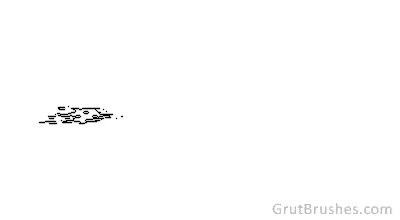What is Digital Art?
Truthfully, there are some bad actors who might put a filter on a photo and market it as an illustration, or generate a picture in a few clicks using Artificial Intelligence - but that's not painting, and it's not the kind of digital art I want to talk about.
Simply speaking, a real digital artist does the same thing freehand on a computer or tablet as they would in a traditional artistic medium. I start by drawing a loose sketch, then turn that into a finished painting, brushstroke by brushstroke, using my hand and a tablet pen!


We just do it in a digital medium instead of a traditional one (like oils, watercolors, pastels, or acrylics). Most of the artists I know use a wide variety of digital brushes to achieve a particular style to their illustrations. My personal collection of brushes does an amazing job replicating the look and feel of charcoal and watercolor -- here's a preview of what it looks like to paint using a digital brush like this!

As you can see, the brush is only going to get you as far as your own skill. The computer won't turn your doodle stick figure into a beautiful Michelangelo (unless you cheat and use an AI image generator... but that's a conversation for another day).
With the widespread accessibility of computers and iPads, young artists are getting started with digital art younger than ever, some even skipping the traditional art route all together. Whether this has a positive or a negative effect on their artwork really depends on the individual. Fundamentals like composition and color theory work the same whether you're working on a physical canvas, or in Procreate.
Digital Art VS Traditional Art
I think everyone who has the opportunity should give digital art a try! Once you get past the initial financial hurdle, digital art is a fun way to express yourself. I sometimes say that digital art is like driving a car, and traditional art is like riding a horse. Traditional mediums take on a life of their own, and sometimes do the unexpected, but that can be part of the fun! Digital art is more technical and mechanical, and reproduces exactly what you put into it.
Is digital art right for you? Let's look at a brief pros and cons list:
Pros
- You have all the colors at your fingertips! Mixing and blending paint is a much simpler (and less messy) affair on a computer.
- You don't need as much room to work! Digital art is a huge space saver, since it can be done on something as small as a tablet. Perfect for studio apartments or kid's rooms where canvases and bottles of paint can quickly clutter a living space.
- An undo button for life's little everyday mistakes. If your cat walks across a wet acrylic painting... Good luck!
- No more waiting for paint to dry. You can save and come back days later, and continue to blend or layer colors as if you never left. Some traditional mediums dry very quickly (acrylics) and some very slowly (oils) but digital art allows you to work on your own schedule.
- Portability. If you're on a laptop or tablet, you can easily take your painting on the go (a desktop, not so much). It's easier to sketch on location digitally than it is to try to set up an easel, or balance watercolors on your knee, trust me!
Cons
- Technical difficulties. Whether the power goes out, your computer crashes, or your tablet is lagging behind on every brush stroke, there's a lot that can go wrong with tech!
- Your art may look a bit different. From screen colors to brush style, your illustration might not turn out how you expect when it's time to print it out!
- Creative computer programs (especially the Adobe Suite) can be expensive! With many companies moving to subscription models, you'll spend a lot of money over time to "rent" this software. Once you buy a bottle of paint, on the other hand, you own that paint forever.
- Painting digitally means you don't have any originals. Everything you make will be a print, or a replication of the digital file. You'll also miss out on the tangible feeling of holding your piece in your hands, or smearing paint with your fingers!
- Eyestrain can become a serious problem when you're staring at a bright screen for long periods of time. Looking at paper or canvas is much easier on the eyes.
I hope this has cleared up some of the misconceptions surrounding digital art, and maybe inspired you to try it out for yourself one day.
In summary... hand drawn digital art is real art. ❤

